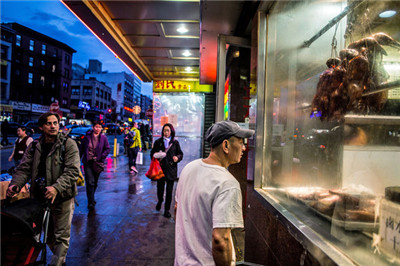(单词翻译:单击)
For my parents, who immigrated from Hong Kong in the 1970s, leaving Chinatown was how you knew you had made it in America. They worked there for 20 years in the garment industry — so that I would never have to, they insisted — but every night they made their proud exit to the New Jersey suburbs. Meanwhile, at school, I was hiding my stinky lunches from my American friends and hoping they wouldn’t hear our alien language.
上个世纪70年代,我的父母从香港移民到美国。对他们来说,逃离唐人街就是在美国站稳脚跟的标志。他们在那儿的一家服装厂工作了20年——他们说这样做是为了我将来不至于也干那样的活儿——但每天晚上,他们都骄傲地离开唐人街,回到新泽西的郊区。与此同时在学校里,我一边要把散发异味的午饭藏起来不让美国朋友们看见,一边暗自希望他们听不见我们说的外语。
But when I finished college, I wanted to know the neighborhood where my parents worked, to be as Chinese as Chinatown could make me. Fifteen years later, I’m still trying to figure out what Chinatown means for Chinese people. Last month, I took just a short walk for lunch but saw, on the streets and in the food, so many ways you can be from somewhere you’re not really from.
但大学毕业后,我开始想要了解父母工作的区域,想变得像唐人街里的中国人一样。如今15年过去了,我还在努力理解唐人街对于中国人的意义。上个月的一天,我为了吃午饭在外面走了一小段路,却发现,原来很多时候,在街上、在食物里,你都能感受到自己的家乡,虽然你根本不是从那儿来的。

Near the Bowery end of Division Street, I passed a spot that used to be the New South Wind restaurant. For 30 years, it served tea from a water heater the size of a plane engine. Lunch could have been rice with canned ham and soy sauce, or dumplings — theirs were big, clunky things with thick, bland skins. I once heard a customer disparage them as “Americanized,” but a friend, born and raised nearby, told me that her grandfather ate there because it reminded him of how the food tasted in his first days in America, when the bachelors of Chinatown made whatever they could with their rudimentary kitchen skills and strange American ingredients.
在蒂法信(Division Street)街靠近包厘街(Bowery)的一端,我路过新南风餐厅(New South Wind restaurant)的旧址,这家餐厅卖了30年茶水,茶都是从一个飞机发动机那么大的烧水炉里接出来的。午餐也许是米饭和火腿罐头,配上酱油,要么就是大饺子,厚厚的饺子皮一点味儿也没有。某次,我听到一位顾客批评这里的食物太“美国化”了,但一个在这儿土生土长的朋友却告诉我,她的祖父来这儿吃饭,就是因为这里的食物让他想起刚到美国时吃的东西。那时候,唐人街的光棍们只能靠自己的一丁点厨艺和手头稀奇古怪的美国调味料做东西吃。
Crossing the Bowery to the living movie set of Doyers Street, I realized that you can still have a little taste of that historical fantasy (with better cooking) at Nom Wah, the oldest dim sum parlor in New York, sanguinely situated on a block constantly bloodied by gang murders when it opened in 1920. Preserved by a young new owner, it still draws crowds, many non-Chinese, hungry for authentic egg rolls. (My parents had never heard of egg rolls until they came here.)
穿过包厘街,来到多也斯街(Doyers Street)存续至今的电影取景地,我发现,过去的美味如今依然能在南华(Nom Wah)品尝到,而且风味更佳。南华点心店开业于1920年,是纽约第一家粤式点心店,尽管当时杀人团伙经常在街区内作案,但南华点心店一直在这个街区好好地开到现在。如今,南华的老板是个年轻人,客人(很多不是中国人)依然络绎不绝地到这儿来品尝正宗蛋卷(我父母来这儿之前压根就没听说过什么蛋卷)。
I’m normally tempted to drop in for one, but I was headed a block away, where a gaggle of young Chinese packed the entryway at Cha Chan Tang. In Hong Kong, eating baked food and creamy sauces was once the privilege of the wealthy, so luncheonettes called cha chaan tengs brought a little of that béchamel class to the masses. This food, called “soy-sauce Western,” included things like baked pork chops on ketchup-sweet spaghetti with the distinct taste of the wok’s fire and oil. It would probably seem awful to you, but for me it occupies the same exact pleasure center as boxed mac and cheese — and for older generations, it tastes a little like success. It’s adaptive and aspirational. Every time someone asks me for the most “authentic” food in Chinatown, I secretly want them to eat this stuff.
通常我都会被馋得去店里买一个,但这次我被吸引到了一个街区外的“茶餐厅”(Cha Chan Tang),门口还挤着一群中国年轻人。在香港,烤肉搭配奶油浇汁曾是富人的专享,所以名为茶餐厅的快餐店为百姓阶层带来了那种调味酱食物。这种食物被称为“豉油西餐”(soy-sauce Western),其中一种是烤猪排骨点缀在番茄酱甜意面上,散发着油炸过的独特味道。听上去可能有点可怕,但在我心中,它带来的幸福感简直堪比盒装奶酪通心粉——而对于年纪稍大的一代人来说,它仿佛有一丝成功的味道。这种食物老少皆宜而且振奋人心。每次有人跟我打听唐人街里最“正宗”的食物时,我心里都想让他们尝尝这玩意儿。
As I ate condensed-milk toast (as good as it sounds) and drank milk tea the texture of cream, I marveled at the décor. Simulated windows open onto an HDTV Hong Kong street scene; stare long enough, and you feel as if you can hop the bus to Kowloon. But it was after stepping back out onto Mott Street that I understood the significance of this place. Naming the restaurant Cha Chan Tang is like naming a coffee shop Coffee Shop; there used to be cha chaan tengs all over Chinatown, but this is something more. It’s a Cantonese theme park, not a place to remind you of home as much as a place to remind you of where your parents used to call home. Everything has the familiarity of things you remember from vacation, but when I ordered, practicing the Cantonese in my head to make sure I had the sounds right, my server caught me off guard with totally unaccented English. He was born here, raised here. This is a new generation of Chinatown, one that doesn’t mind staying.
我吃着炼乳吐司(和听上去一样好吃),喝着奶茶,感受着丰富泡沫的口感,店里的装潢也让我震惊。打开的仿真窗户正对着高清电视上的香港街景;盯着多看一会儿,仿佛就能搭上去九龙的巴士。后来走回到莫特街上,我才想通这个餐厅的意义。这家店起名“茶餐厅”,就好比咖啡店的名字起做“咖啡店”。曾经,唐人街上到处都是茶餐厅,但这家店和那些有所不同。它是一个广东主题公园,并不是让你怀念家乡的地方,而是让你怀念父母一辈过去称为家乡的地方。一切都和假期里的记忆吻合,但当我点菜前在脑海中练习粤语,想确保发音准确时,服务生纯正的英语却令我猝不及防。他在这儿出生,也在这儿长大。这是唐人街的新一代,是不介意留下的一代。
On the walk back to the subway, I went under the Manhattan Bridge on Division. There, in storefront employment agencies, men just-arrived in this country go to find jobs serving $4.95 General Tso’s. Most of these agencies are nothing more than a desk, a counter, a map on the wall; the new immigrants learn words like “Nebraska” and “Newport News” before stepping onto a bus outside and making those words their homes. I saw a man walk into one, leathery skinned, looking slightly lost, a small slip of paper in his hand. And I wondered: Where will he want his kids to work one day? Where will he want them to go, or stay away from, to know that he has made it?
回地铁站的路上,我从曼哈顿大桥下的蒂法信街上走过。初到美国的人们在街边的求职中介里寻份工作——在餐厅里端4.95美元(约合30.7元人民币)的左宗棠鸡。大多数中介里不过摆着一张桌子,一个柜台,墙上挂着张地图。新来的移民们学着“内布拉斯加州”和“新港新闻”之类的词,搭上一辆外面的巴士,去往这些词所代表的地方,那儿将成为他们的家。我看见一个皮肤粗糙的男人走进一家求职中介,手里拿着张纸条,看起来有点恍惚。我很想知道:他以后会想让自己的孩子去哪儿工作呢?他想让他们去哪儿,又远离哪儿来,以此证明自己在这里站稳脚跟了呢?


